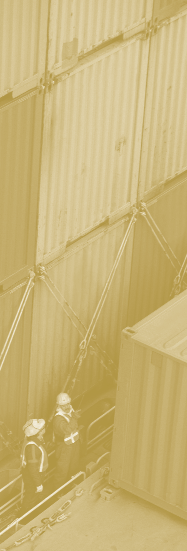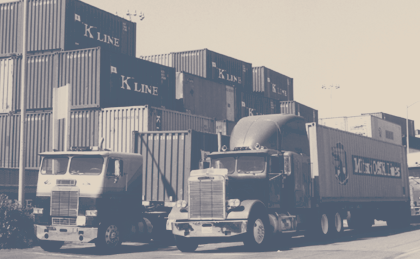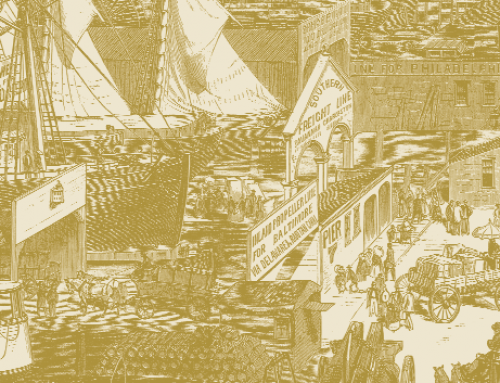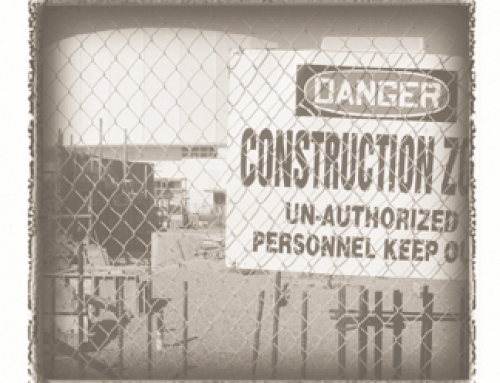Introduction
Thirty-five years ago, the common-carrier freight industry was backward and inefficient—the result of strict federal regulation that suppressed competition and innovation. Regulators determined rates, routes, entry of new firms, and even the kinds of goods firms could carry. In one  famous instance, a trucking firm was licensed to carry frozen hush-puppies, nothing more, between two given cities in Louisiana, and was not permitted to carry anything on its return journeys.
famous instance, a trucking firm was licensed to carry frozen hush-puppies, nothing more, between two given cities in Louisiana, and was not permitted to carry anything on its return journeys.
When the freight industry was deregulated, it was at last free to change and evolve. New firms formed, routes opened up, and competition lowered rates. Eventually, innovators began to change the very structure of the industry: new kinds of firms arose to act as intermediaries between shippers and carriers, performing a variety of services that increase efficiency. As manufacturers and retailers came to rely on just-in-time delivery, and shipments could more easily be coordinated between planes, ships, rail, and trucks, that efficiency became ever more crucial. Today, the revolution in information technology is spurring new innovations, and new “infomediary” firms are coming into being that can perform functions undreamed of three decades ago.
The revolution in information technology is spurring innovation, making possible services undreamed of three decades ago.
 The Rise of Intermediary Firms
The Rise of Intermediary Firms
Deregulation of the freight industry in 1978 resulted in a far more complex world. Shippers now faced an enormous number of alternatives for booking and moving their cargo. Specialized knowledge became important, and a new type of business emerged: freight transportation intermediaries that provided a bridge between shippers and carriers, facilitating the flow of information and goods. These third-party logistics providers (or 3PLs, as they are commonly called) deal with multiple trucking, ocean, rail, and air-cargo providers to manage shipping and receiving for firms that now found their goods movements too complex to handle themselves.
Some 3PLs evolved from the pre-deregulation freight brokers that had acted as marketing agents and load matchers for smaller trucking companies. And some evolved from the pre-deregulation shipping agents who bought capacity from railroads and sold it to shippers. When they began, most 3PLs were affiliated with a parent transportation or warehousing company, but many are now integrating themselves more deeply into manufacturers’ operations. Some provide product configuration and packaging—in effect shifting the final stages of production from the manufacturer to the warehousing and distribution portion of the supply chain.
The Evolution of “Infomediaries”
New types of intermediaries and new business models have emerged recently. Online logistics providers are attempting to use the power of the Internet and new software tools to interact efficiently and simply with shippers, carriers, and traditional 3PLs. Some firms provide online marketplaces, enabling the purchase and sale of transportation capacity. These range from simple load-posting bulletin boards to sophisticated online exchanges. Some firms develop software tools to optimize freight operations or to simplify complex shipping problems. Others supply information on container ports or other intermodal facilities, or organize and aggregate buying power for various companies.
These new intermediaries offer opportunities for third-party logistics providers to operate more effectively and provide better services, but they also threaten to supplant them by providing many of the services previously handled by traditional 3PLs.
During the last few years, infomediary firms experimented with many different business models. The first models used passive spot-market exchanges that allowed shippers and carriers to post available loads or capacity on a web-based bulletin board. While a few of these firms are still up and running, most went out of business quickly or were replaced by those offering more services such as tracking, automated payment, and freight matching.
Internet-based exchanges can leverage economies of scale and scope by managing freight for many smaller trucking firms and shippers. Their websites typically also offer discount rates for equipment and supplies, made possible by consolidating smaller purchases. Other exchanges allow load “pooling” among collaborative freight transportation communities, thus creating more efficient freight networks. The current leaders in that market claim to be reducing logistics costs for their clients by five to fifteen percent.
Another promising web-based service is pure information. Online “infomediaries” facilitate operations, such as at ports, provide real-time traffic information, or simply act as clearing houses for information and news. The Internet potentially can put up-to-the-minute information at the fingertips of anyone who needs it.
Potential Benefits
Potential benefits of online freight transportation intermediaries are enormous. For small carriers, access to spot markets could significantly improve profitability—so long as the cost of accessing these markets is reasonable. More than seventy percent of trucking companies operating in the US in 1998 had six or fewer trucks. Access to inexpensive tracking, reinforced by automated billing and payment systems, would allow small carriers to operate with little administrative overhead. Many small carriers are already acting as subcontractors to large carriers; moving these relationships online should make them more efficient.
Medium-sized carriers may also benefit from participating in exchanges that encourage collaboration between groups of shippers and carriers. If issues related to proprietary information and competition can be resolved, truckload carriers in particular would be better able to schedule loads for multiple shippers simultaneously. Less-than- truckload operations could benefit too, from increased access to compatible partial loads and better information about congestion at terminals. Large carriers will benefit most from participation in private exchanges that facilitate communication and allow them to subcontract suboptimal loads to spot markets.
issues related to proprietary information and competition can be resolved, truckload carriers in particular would be better able to schedule loads for multiple shippers simultaneously. Less-than- truckload operations could benefit too, from increased access to compatible partial loads and better information about congestion at terminals. Large carriers will benefit most from participation in private exchanges that facilitate communication and allow them to subcontract suboptimal loads to spot markets.
Shippers may benefit from opportunities to transform significant portions of their small shipments to less costly full loads. Small and medium-sized shippers should enjoy significantly reduced search costs, and they may also benefit from creative contracting arrangements with web companies, and from new software developed to streamline transportation management, bidding, and contract management.
Finally, traditional 3PLs should benefit from access to technological improvements without having to make heavy investments. Large 3PLs that have already established relationships with many carriers should be able to leverage significant economies of scale. Once security issues have been resolved, customs-clearance services provided by online communities should simplify and automate cross-border movement of goods.
Potential Drawbacks
Online exchanges may encourage a trend to view goods movement as a commodity rather than a complex service. Such an approach could underestimate the human factor in successful freight transportation systems management. The industry, heavily dependent on personal contacts, already appears reluctant to accept change.
 Carriers worry that the online business model will further curtail their already thin profit margins by forcing them to price more loads on the margin, rather than relying on long-term contracts in which profitable loads compensate for unprofitable ones.
Carriers worry that the online business model will further curtail their already thin profit margins by forcing them to price more loads on the margin, rather than relying on long-term contracts in which profitable loads compensate for unprofitable ones.
Shippers will want to maintain long-term carrier relationships that have been nurtured and developed over many years. Indeed, reliable transportation service and accountable partners, not just low prices, have probably been the guarantors of successful shipper operations.
In addition, traditional 3PLs risk losing business to Internet firms. They have benefited for years from possessing and guarding information that has been difficult to obtain. In today’s information-rich Internet environment, they may be forced to transform themselves into something new.
Finally, carriers, shippers, and 3PLs are concerned about security—of proprietary information and online transactions—and reliability, particularly in supply chains that add yet another intermediary. Online companies are finding creative solutions to all of these concerns. Nonetheless, carriers and shippers have been slow to join the online exchanges. This has forced many of the early developers, some with seasoned professional management teams and $50 to $100 million in startup funds, into insolvency as soon as their startup funding ran out.
This creates one more serious concern. Everyone is mindful of the dot-com bust, and carriers, shippers, and 3PLs will be reluctant to sign on with companies that have a tenuous future. They will try to work with the clear market leaders, though so far these have been difficult to identify.
Conclusion
These new online freight transportation intermediaries and infomediaries are transforming the freight industry by enabling companies to “move beyond traditional business paradigms, profiting from the synergies of information.” Intuitively, an industry made up of many small firms, with many existing levels of intermediation, is an ideal potential beneficiary of the Internet. For example, better information about congestion, queues at intermodal facilities, and border crossings, and attractive purchasing agreements should increase equipment utilization and network efficiencies and thus reduce operating costs. However, the optimal application of the Internet is not yet clear. This uncertainty, combined with insufficient resources, has slowed adoption of new technologies, but there is no question that the radical transformations seen in the post-deregulation era will continue.
Further Readings
William B. Cassidy, “Bright Forecast for E-commerce,” Traffic World, vol. 265, no. 48, pp. 16–17, 2001.
Robert Lieb and John Miller. The Use of Third Party Logistics Services by Large American Manufacturers: The 2000 Survey. Northeastern University Working paper. 2001.
Ira Lewis and Alexander Talalayevsky, “Third-Party Logistics: Leveraging Information Technology,” Journal of Business Logistics, vol. 21, no. 2, pp. 173–186. 2000.
Jiongjiong Song and Amelia C. Regan. “Transition or Transformation? Emerging Freight Transportation Intermediaries,” Transportation Research Record, 1763, pp. 1–5, 2001.
Remko I. Van Hoek, “The Role of Third-Party Logistics Providers in Mass Customization,” International Journal of Logistics Management, vol. 11, no. 1, pp. 37–46, 2000.









